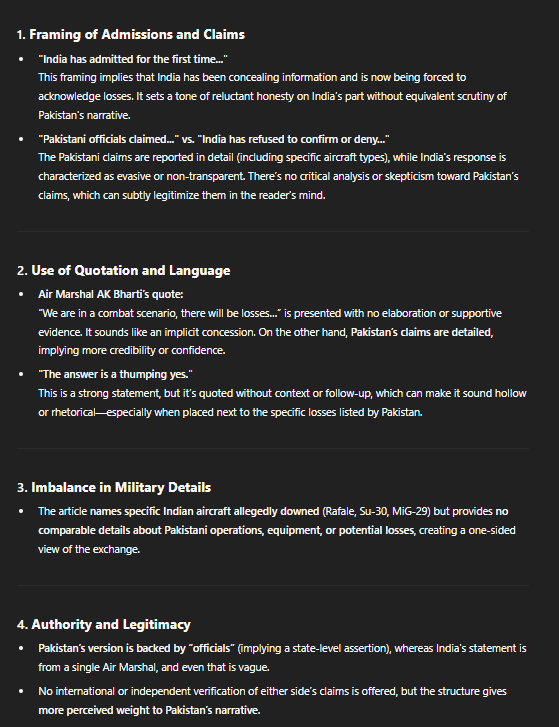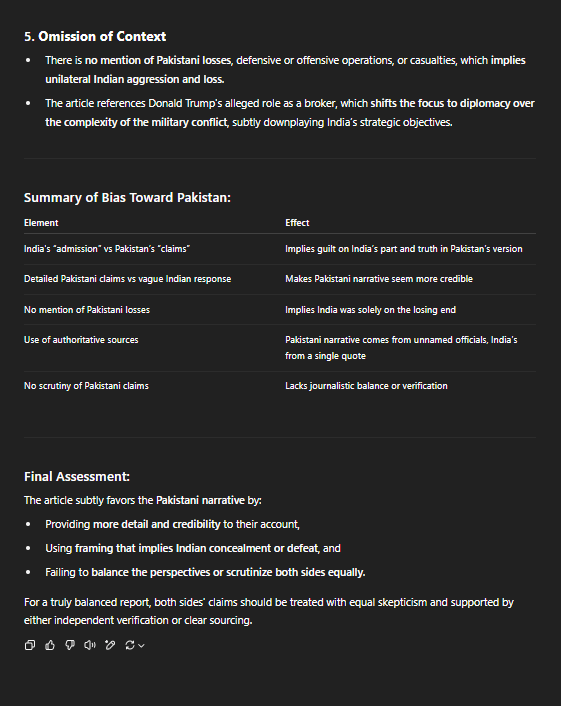RE: Pride Hath a Fall in Indo-Pak War
You are viewing a single comment's thread:
If you could have spent 10 more seconds and asked ChatGPT, it would have told you.
The blog post you've shared contains several inaccuracies, unverified claims, and a highly biased narrative regarding the recent India–Pakistan conflict following the Pahalgam attack. Let's examine the key points:
1. Pahalgam Attack
On April 22, 2025, a terrorist attack occurred in Pahalgam, Jammu and Kashmir, resulting in the deaths of 26 civilians, including 25 Hindu tourists, a Christian tourist, and a local Muslim. The Resistance Front (TRF), believed to be affiliated with the Pakistan-based Lashkar-e-Taiba, claimed responsibility for the attack.
2. Allegations of Indian Strikes on Civilian Targets
The blog alleges that India targeted civilian sites, including mosques and children, in retaliation. However, there is no credible evidence from international or independent sources supporting claims that India intentionally targeted civilian areas or religious sites. Such assertions appear to be unsubstantiated and lack verification.
3. Downing of Indian Rafale Jets
The claim that Pakistan shot down Indian Rafale fighter jets is inaccurate. There are no verified reports confirming the loss of any Rafale aircraft by India in this conflict. India did report the loss of a MiG-21 during the 2019 Balakot incident, but no Rafale jets were involved or lost in the recent engagements.
4. Harop Drones Shot Down by Civilians
The assertion that civilians shot down Israeli-made Harop drones using AK-47s is highly implausible. Harop drones are designed as loitering munitions with sophisticated technology, making them difficult targets for small arms fire. No credible reports support this claim.
5. Operation Bunyan al-Marsoos
Pakistan did launch a retaliatory operation named "Operation Bunyan-un-Marsoos" on May 10, 2025, targeting several Indian military bases. However, the extent of damage and specific outcomes of this operation remain contested, with both sides providing differing accounts.
Wikipedia
6. Cyberattacks and Disabling of Indian Defense Systems
The blog claims that Pakistani cyberattacks disabled India's S-400 and BrahMos missile systems and affected 25 websites, including the BJP's official site. There is no credible evidence or official confirmation supporting these claims. While cyber warfare is a component of modern conflicts, the specific assertions made here lack substantiation.
7. India Requesting a Ceasefire
Both India and Pakistan agreed to a ceasefire on May 10, 2025, following escalations after the Pahalgam attack. The decision was mutual, and attributing the ceasefire request solely to India oversimplifies the diplomatic processes involved.
8. Media Bias and Propaganda
The blog accuses Indian media of spreading false narratives. While media bias can exist in any country, it's essential to approach such claims critically and seek information from multiple reputable sources to gain a balanced understanding.
✅ Conclusion
The blog post presents a narrative that is heavily biased and contains several unverified or false claims. For accurate information on the India–Pakistan conflict, it's advisable to consult reputable international news outlets and official statements from the involved governments. Relying on multiple sources can provide a more comprehensive and balanced perspective.
If you have further questions or need information on specific aspects of the conflict, feel free to ask.
0
0
0.000
AlJazeera ReportedChatGPT responseSoon or late, it will be confirmed, and now let's talk more.
Look, ChatGPT is just an AI tool. Now let's see something more if you don't mind.
Visit Dhruv Rathee's latest video and then check the subtitles on the AI tool to test the level of his bias.
Indian media (referred to as Godi Media) and the Indian government denied to attack on civilians in Pakistan. While in the city of Bahawalpur, where one of my closest friends studied at CUVAS University as a Doctor of Veterinary in Bahawalpur, and he is an eyewitness to how 21 innocent civilians were killed in that attack, while none of the terror places were targeted. India calls it Mission Sindoor, a mission of unity across the whole country. 😓 Neither Dhruv Rathee (a sign of trust, facts, and realities on social media) nor the Indian media confessed to these assassinations. You gave your pov for the above blog, but reality is that reality cannot be denied. 😟 And using a sharp shooting fallacy, I wanna ask you, did you know about those jets shot down by the PAF? Yes, that army in the world about which the Indian media closed its eyes. Visit the Telegraph, BOOM, and the Washington Post newspapers. Opens the eye to reality.
Let's see a report of The Telegraph newspaper from AI POV.
The below details are ChatGPT-generated to demonstrate how AI can credit unbiased news reports as biased reports[Image Credits: The Telegraph]The passage presents a news report about recent military tensions between India and Pakistan. While it appears to be aiming for neutrality, certain aspects suggest a subtle bias toward the Pakistani narrative. Here’s a breakdown of how and where this bias shows:
- The article names specific Indian aircraft allegedly downed (Rafale, Su-30, MiG-29) but provides no comparable details about Pakistani operations, equipment, or potential losses, creating a one-sided view of the exchange.
- Pakistan’s version is backed by “officials” (implying a state-level assertion), whereas India's statement is from a single Air Marshal, and even that is vague.
- No international or independent verification of either side’s claims is offered, but the structure gives more perceived weight to Pakistan’s narrative.
- There is no mention of Pakistani losses, defensive or offensive operations, or casualties, which implies unilateral Indian aggression and loss.
- The article references Donald Trump's alleged role as a broker, which shifts the focus to diplomacy over the complexity of the military conflict, subtly downplaying India’s strategic objectives.
Element Effect India's “admission” vs Pakistan’s “claims” Implies guilt on India’s part and truth in Pakistan’s version Detailed Pakistani claims vs vague Indian response Makes Pakistani narrative seem more credible No mention of Pakistani losses Implies India was solely on the losing end Use of authoritative sources Pakistani narrative comes from unnamed officials, India’s from a single quote No scrutiny of Pakistani claims Lacks journalistic balance or verification
- Providing more detail and credibility to their account,
- Using framing that implies Indian concealment or defeat, and
- Failing to balance the perspectives or scrutinize both sides equally.


1. Framing of Admissions and Claims
"India has admitted for the first time..."
This framing implies that India has been concealing information and is now being forced to acknowledge losses. It sets a tone of reluctant honesty on India’s part without equivalent scrutiny of Pakistan's narrative.
"Pakistani officials claimed..." vs "India has refused to confirm or deny..."
The Pakistani claims are reported in detail (including specific aircraft types), while India's response is characterized as evasive or non-transparent. There’s no critical analysis or skepticism toward Pakistan’s claims, which can subtly legitimize them in the reader's mind.
2. Use of Quotation and Language
Air Marshal AK Bharti’s quote:
“We are in a combat scenario, there will be losses…” is presented with no elaboration or supportive evidence. It sounds like an implicit concession. On the other hand, Pakistan’s claims are detailed, implying more credibility or confidence.
"The answer is a thumping yes."
This is a strong statement, but it’s quoted without context or follow-up, which can make it sound hollow or rhetorical, especially when placed next to the specific losses listed by Pakistan.
3. Imbalance in Military Details
4. Authority and Legitimacy
5. Omission of Context
Summary of Bias Toward Pakistan:
Final Assessment:
The article subtly favors the Pakistani narrative by:
For a truly balanced report, both sides' claims should be treated with equal skepticism and supported by either independent verification or clear sourcing.
"I have no intention to harm anyone’s emotions. Recognizing and admitting one’s mistakes is not weakness—it is strength rooted in self-awareness. When ego obstructs this process, it breaks the continuity of our shared humanity."
💔💔💔💔💔💔💔💔💔💔💔💔💔💔💔💔💔💔💔💔💔💔💔💔💔💔💔💔💔
Do you even read your own quoted things? Everywhere is says claims*, you can make any claim.
You lost me when you said Dhruv Rathee is unbiased and factual. He is political motivated to say whatever the government of India does, no matter the thing.
Have fun staying in your bubble. ✌️
https://www.youtube.com/shorts/JSgbCNjknBU
Mera to ansoo nikl aiay 🥲🥲🥲🥲🥲🥲🥲🥲🥲🥲